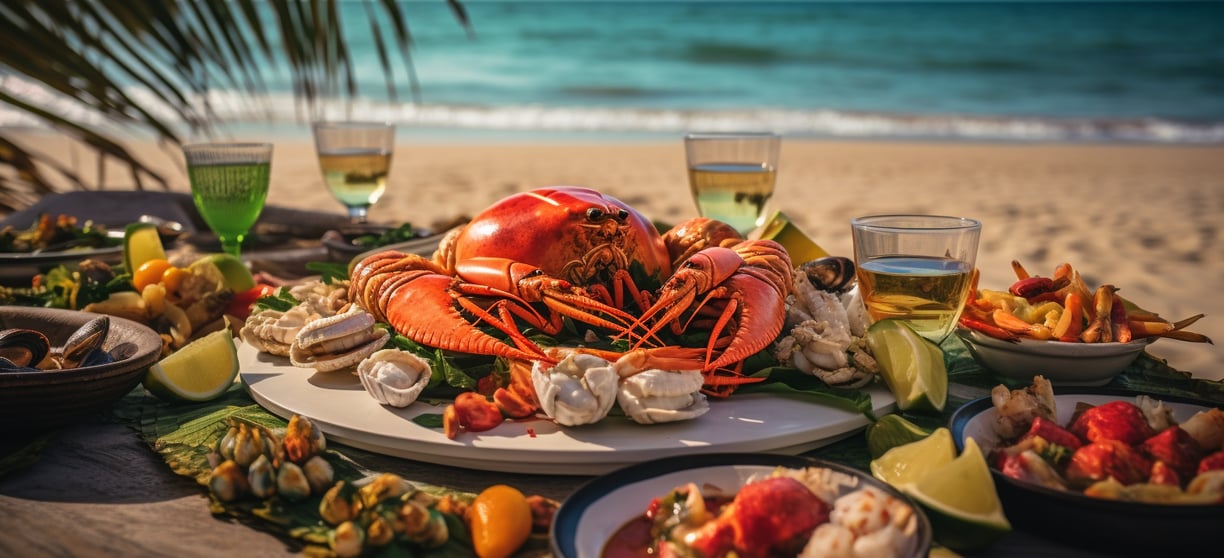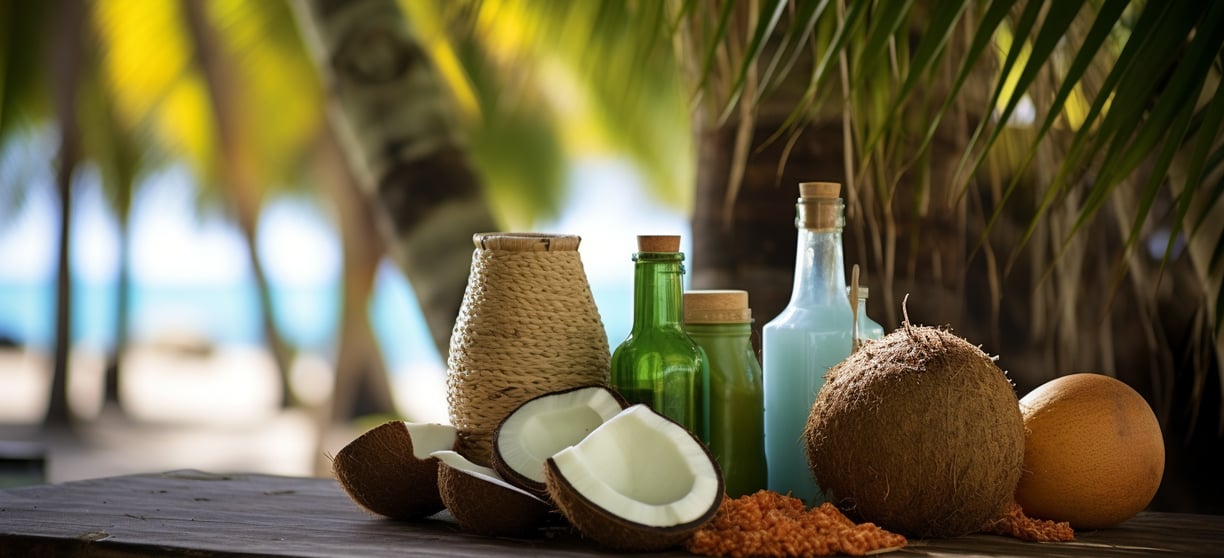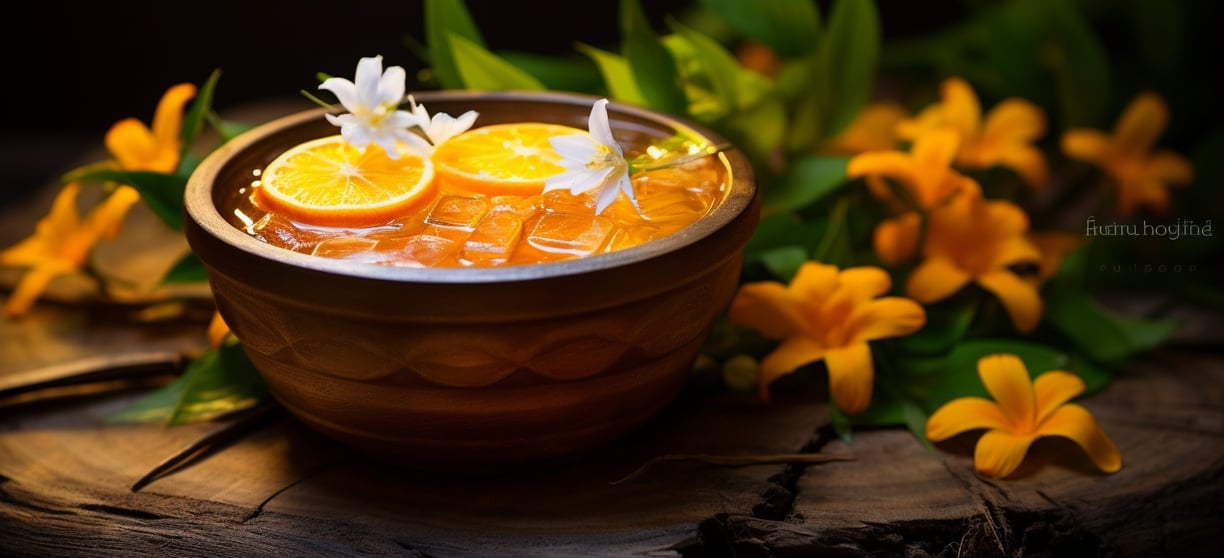Island Cuisine 101: Savoring the Flavors of the Cook Islands
Embark on a culinary journey through the Cook Islands, where every bite tells a story of tradition and flavor.

Located in the heart of the South Pacific, the Cook Islands offer much more than just breathtaking beaches and crystal-clear waters. A trip to these enchanting islands is incomplete without indulging in their vibrant and flavorful cuisine. From rich heritage dishes to modern interpretations, Cook Islands cuisine offers a delightful blend of traditional flavors and contemporary influences. This article will take you on a gastronomic journey through the flavorsome world of Cook Islands cuisine, exploring its culinary heritage, key ingredients, traditional dishes, and the vibrant food scene that awaits you.
Understanding the Culinary Heritage of the Cook Islands
The culinary heritage of the Cook Islands is deeply rooted in Polynesian culture. The fusion of ancient Polynesian traditions and European influences has resulted in a distinct island cuisine that tantalizes the taste buds of locals and visitors alike.
When exploring the culinary landscape of the Cook Islands, one cannot ignore the rich and vibrant flavors that have been passed down through generations. The islanders have a deep appreciation for their natural surroundings, and this is reflected in the ingredients and cooking techniques used in their traditional dishes.
One of the key aspects of Cook Islands cuisine is the influence of Polynesian culture. The Polynesians have a strong connection to the land and sea, and this is evident in the choice of ingredients used in their dishes. Staples such as taro, breadfruit, and coconuts take center stage in a variety of dishes, showcasing the islanders' reliance on the bounties of nature.
The Influence of Polynesian Culture on Cook Islands Cuisine
The Polynesian culture has played a significant role in shaping the flavors and techniques of Cook Islands cuisine. The islanders have a deep respect for the land and sea, and this is reflected in their culinary practices. Traditional cooking methods, such as earth oven cooking, are still used today, infusing dishes with a unique smoky flavor.
Moreover, the Polynesians have a strong sense of community, and this is often reflected in the way meals are prepared and shared. Cooking is seen as a communal activity, with families and friends coming together to prepare and enjoy meals. This sense of togetherness adds an extra layer of richness to the culinary heritage of the Cook Islands.
The Role of Seafood in Island Cuisine
Being surrounded by the bountiful Pacific Ocean, it's no surprise that seafood holds a special place in Cook Islands cuisine. Freshly caught fish and shellfish are prepared using traditional techniques, ensuring that every bite is full of flavor and reflects the islanders' deep respect for the ocean.
The islanders have a deep understanding of the ocean and its resources, and this is evident in the way they harvest and prepare seafood. Traditional fishing methods, such as using nets and spears, are still practiced today, ensuring that the delicate balance of marine life is maintained.
From succulent grilled fish to mouthwatering seafood curries, the Cook Islands offer a wide array of seafood dishes that showcase the islanders' expertise in preparing and cooking these treasures from the sea. Whether it's a simple fish ceviche or a hearty seafood stew, every dish tells a story of the islanders' deep connection to their environment.
Key Ingredients in Cook Islands Cuisine
When it comes to the culinary delights of the Cook Islands, seafood undoubtedly takes pride of place. However, the island's gastronomic repertoire extends far beyond the bounties of the ocean. The cuisine of the Cook Islands boasts a range of other key ingredients that add depth, complexity, and flavor to their dishes, creating a culinary experience that is truly unforgettable.
The Importance of Coconut in Island Dishes
One ingredient that holds a special place in the hearts and palates of the Cook Islands' inhabitants is the versatile and essential coconut. Known as the "tree of life," the coconut plays a crucial role in the local cuisine, providing not only sustenance but also a distinct tropical flavor that elevates the dishes to new heights.
From the luscious coconut cream and milk that forms the base of many traditional dishes to the grated coconut used as a garnish, the presence of this tropical fruit is ubiquitous in Cook Islands cuisine. The rich and creamy coconut cream adds a velvety texture and a subtle sweetness to curries, soups, and sauces, while the fragrant coconut milk infuses dishes with a delicate aroma that tantalizes the senses.
Furthermore, the use of coconut oil in cooking imparts a unique flavor profile that is both nutty and slightly sweet. This versatile oil is not only used for frying and sautéing but also as a dressing for salads or a drizzle over grilled seafood, adding a delightful tropical twist to every bite.
Taro Roots and Leaves: A Staple of Cook Islands Food
Another ingredient that holds a prominent place in Cook Islands cuisine is the humble taro. Taro roots and leaves, with their earthy flavor and nutritional value, are a staple in the local diet and are used in a variety of traditional dishes.
The taro root, often referred to as "the potato of the tropics," is a starchy tuber that forms the basis of many hearty and comforting dishes. It can be boiled, mashed, roasted, or even made into crispy taro chips, offering a satisfying and substantial element to the cuisine. The taro leaves, on the other hand, are commonly used as a wrapping for various fillings, creating delicious parcels of flavor that are steamed or baked to perfection.
Not only do taro roots and leaves provide a unique taste and texture to the dishes, but they also offer a range of health benefits. Rich in dietary fiber, vitamins, and minerals, taro is a nutritious addition to any meal, ensuring that the Cook Islands' cuisine not only delights the taste buds but also nourishes the body.
When combined with the abundant seafood and other key ingredients, such as fragrant herbs, tropical fruits, and aromatic spices, the taro roots and leaves create a harmonious symphony of flavors that truly embodies the essence of Cook Islands cuisine.

Traditional Dishes of the Cook Islands
No exploration of Cook Islands cuisine would be complete without diving into their traditional dishes. Here are two iconic dishes that capture the essence of the islands.
Ika Mata: The National Dish
Ika Mata is a refreshing dish that showcases the deep connection between the Cook Islands and the ocean. The Cook Islands, surrounded by crystal-clear waters teeming with an abundance of marine life, have a long-standing tradition of utilizing fresh seafood in their cuisine. Ika Mata, the national dish of the Cook Islands, is a testament to this culinary heritage.
The dish is made with marinated raw fish, typically using local varieties like tuna or snapper. The fish is diced into bite-sized pieces and then marinated in a mixture of coconut cream, lime juice, and a medley of fresh vegetables. The vibrant colors of the vegetables, such as red bell peppers, tomatoes, and onions, add a visually appealing element to the dish.
The combination of the tangy lime juice, creamy coconut cream, and the natural flavors of the fish creates a harmonious blend of tastes that is both refreshing and satisfying. The dish is often garnished with freshly chopped herbs, such as coriander or mint, to add an extra layer of freshness.
Ika Mata is not only a culinary delight but also a cultural symbol for the Cook Islands. It represents the islanders' deep respect and reliance on the bountiful ocean that surrounds them. Every bite of this dish is a celebration of the island flavors and a reminder of the Cook Islands' close relationship with the sea.
Rukau: A Taro Leaf Delicacy
Rukau is a traditional dish that pays homage to the versatile taro plant, which holds a special place in Cook Islands cuisine. Taro, a starchy root vegetable, is a staple crop in the region and is used in various dishes. Rukau, made with taro leaves, is a beloved delicacy that showcases the unique flavors and textures of this versatile plant.
The dish begins by carefully selecting young taro leaves, known for their tenderness and vibrant green color. The leaves are then cooked until tender, either by steaming or boiling, to ensure they retain their natural flavors and nutrients. Once cooked, the leaves are finely chopped and mixed with creamy coconut milk and sautéed onions.
The combination of the earthy flavors from the taro leaves, the richness of the coconut milk, and the savory sweetness of the onions creates a delightful taste experience. The smooth texture of the dish adds to its appeal, making it a popular side dish among the locals.
Rukau is not only a delicious dish but also a reflection of the Cook Islands' agricultural heritage. Taro has been cultivated in the region for centuries, and its importance in the local cuisine is deeply ingrained in the islanders' culture. Each bite of Rukau is a tribute to the land and the traditional farming practices that sustain the Cook Islands.
Exploring the traditional dishes of the Cook Islands is like embarking on a culinary journey that unveils the rich flavors, cultural significance, and deep connection to the land and sea. Whether it's the tangy and vibrant Ika Mata or the earthy and smooth Rukau, these dishes offer a glimpse into the heart and soul of the Cook Islands' gastronomic heritage.
Modern Interpretations of Cook Islands Cuisine
As the culinary world evolves, so does Cook Islands cuisine. Modern interpretations of traditional dishes and the fusion of international flavors have given rise to exciting new culinary experiences.
Fusion Cuisine: Blending Traditional and Modern Flavors
Cook Islands chefs are embracing fusion cuisine, infusing traditional dishes with modern flavors and techniques. This dynamic approach results in unique culinary creations that showcase the rich heritage of the islands while catering to diverse palates.
The Rise of Gourmet Island Cuisine
Gourmet island cuisine is gaining popularity in the Cook Islands, offering a refined dining experience that showcases the islands' diverse flavors and ingredients. From upscale resorts to independent restaurants, you'll find a wide range of options to satisfy your taste buds.

Exploring the Cook Islands' Food Scene
Immersing yourself in the vibrant food scene of the Cook Islands is a must for any culinary enthusiast. Whether you're strolling through bustling local markets or indulging in street food, there are endless opportunities to discover the flavors and traditions of the islands.
Street Food and Markets: A Taste of Local Life
The local street food scene offers a wonderful opportunity to taste the authentic flavors of the Cook Islands. Grab a piping hot plate of fried banana fritters or try some mouthwatering fish wraps bursting with island spices. Don't forget to explore the colorful markets, which are brimming with fresh produce and homemade delicacies.
Fine Dining in the Cook Islands: A Culinary Adventure
For a more upscale dining experience, the Cook Islands boast a range of fine dining establishments that showcase the islands' unique culinary offerings. Indulge in a gourmet feast prepared by talented chefs, who use locally sourced ingredients to create dishes that are as visually stunning as they are delicious.
In conclusion, exploring the flavors of Cook Islands cuisine is a vital part of any visit to this tropical paradise. From the rich culinary heritage to the exciting modern interpretations, the gastronomic experiences in the Cook Islands are bound to leave you craving for more. So, pack your bags, book your tickets, and embark on a culinary adventure that will tantalize your taste buds and create memories that will last a lifetime!